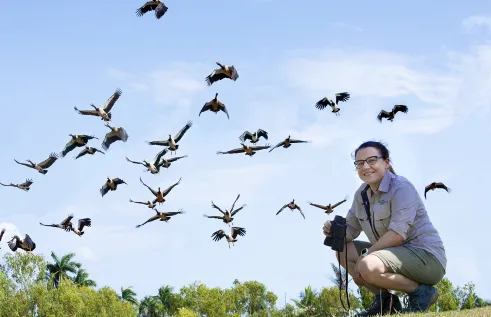Why investigate savanna and arid ecology with RIEL?
North Australia hosts the largest intact tropical savanna in the world
70 per cent of Australia is arid or semi-arid and yet many ecosystems here aren’t well understood
Savanna and arid regions have outstanding ecological, economic and cultural values
Savanna and arid ecology
RIEL strives to make a real-world impact. We collaborate and engage with a wide range of research and industry partners to ensure that we contribute to the knowledge and sustainable management of unique savanna and arid ecosystems.
This work includes:
- Assessing the ecosystem responses to changes in fire frequency, climate and land use change;
- Quantifying and modelling carbon and water cycles in north Australian ecosystems;
- Researching environmental impacts and behavioural adaptations of invasive and feral animal and plant species;
- Examining the impacts of deforestation on greenhouse gas emissions and water resources in northern Australia;
- Investigating the restoration of ecosystems and ecosystem services following mining;
- Studying physiological adaptations of amphibians and reptiles to savanna and arid environments;
- Developing innovative methodologies to evaluate climate change impacts on turtle breeding in the Amazon;
- Implementing a world first program for a savanna burning carbon industry in Northern Australia;
- Understanding the role of biodiversity hotspots and refuge ‘islands’ in a ‘sea’ of savanna;
- Leveraging space technology and big data analytics for mapping and monitoring essential biodiversity variables.
People and projects snapshot
-

Weeds and fire, a dangerous relationship
Ecological, economic, social and cultural assets of the Top End are seriously threatened by weeds and changed fire patters. Our researcher Natalie Rossiter-Rachor investigates gamba grass and its impacts in this NESP Northern Hub funded project.
Read more -

Monitoring Healthy Country in Kakadu
Bininj/Mungguy Traditional Owners, rangers and researchers, including RIEL Research Associate Jen Macdonald, are working together to identify indicators and methods for determining landscape health. This approach is being trialled at three sites, before and after management activities are undertaken and will and contribute to Kakadu’s ongoing management efforts.
Watch the video -

Weather radars reign for info on flying animals
Scientists are using weather radars, originally developed to measure rainfall, to study the flight patterns of birds, bats and insects. A researcher claims, however, that we should use radars to measure flying animals more often.
Read More
Interested in savanna and arid ecology?
Publications snapshot
-

Stocktaking cat kills
The likelihood of being killed by a cat is highest for native mammals that aren’t bats, live in low rainfall areas, non-rocky areas, and/or weigh between 35-5500g, such as mulgaras, stick-nest rats, and barred bandicoots.
Image credit: Dept of Environment & Natural Resources, NT Gov
Read more -

Mapping weed spread
In Kakadu National Park dense para grass is displacing ecologically, genetically and culturally significant species, including Australian native rices.
Read more -

How mobile are mulga birds?
Assessment of avian site fidelity in arid Acacia shrubland based on a ten-year mark-recapture study in central Australia.
Read more
